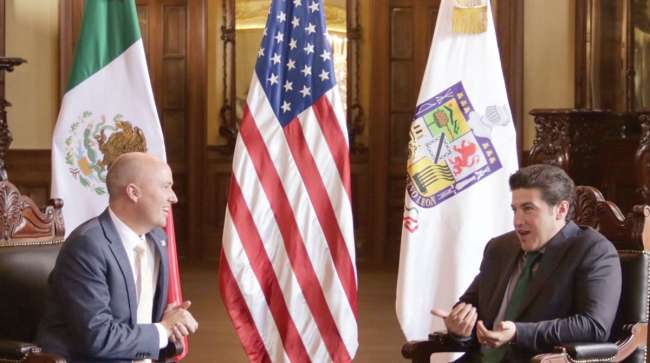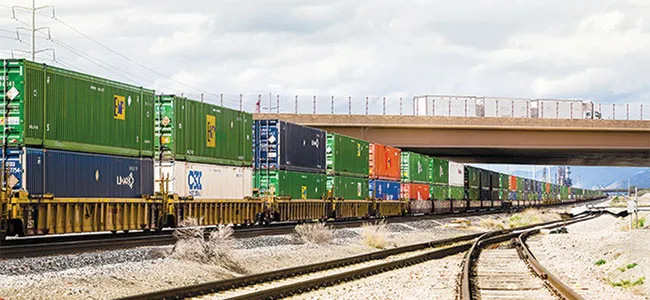Staff Reporter
Utah Seeks to Boost Trade With Mexico, Pushes Port Plan

[Stay on top of transportation news: Get TTNews in your inbox.]
Utah Gov. Spencer Cox unveiled the state’s strategic agreement with Mexico to improve bilateral trade as Utah’s developing Inland Port Authority marches ahead in an ambitious plan to become a global logistics connector in the West.
Cox announced Oct. 25 the “Joint Utah Mexico Partnership” initiative from his Office of Economic Opportunity and the Mexican Consulate in Salt Lake City.
“Our relationship with Mexico is the most important international alliance Utah has,” Cox said. “We have long enjoyed economic and diplomatic connections that have been mutually beneficial, and this plan will only strengthen our ties.”
A few days earlier, Cox led a 34-member state delegation trade mission to Mexico City and other leading sites, where he presented the state’s 18-page plan in meetings with Mexican government leaders.
Mexican Secretary of Foreign Affairs Alicia Bárcena applauded Utah’s plan, which seeks to provide Mexican companies with better access to Utah. “We celebrate this type of initiative. It’s important that we make the most of the excellent state of Mexico-U.S. relations to deepen our economic ties and build together a true binational and regional community that increases trade, social inclusion and job creation,” she said.
Our trade mission in Mexico is coming to an end!
We’ve enjoyed meeting with Mexican government officials and business leaders to build economic relationships and create new opportunities. Mexico is Utah’s third-largest trading partner and with our new Joint Utah Mexico… pic.twitter.com/mO6lYWp7M5 — Utah Gov. Spencer J. Cox (@GovCox) October 27, 2023
Utah’s plan establishes 12 key areas to improve bilateral ties with Mexico across business and trade, workforce/talent, culture/belonging and foreign language acquisition.
“As a crossroads, Utah’s freeways, railways and direct flights connect freight, business and personal travelers, including five direct flights to Mexico City,” Ryan Starks, state economic opportunity executive director, said in the joint agreement dated in August.
Trade with Mexico supports 51,000 state jobs and totaled $5.6 billion in 2022. Mexico is Utah’s largest import partner, as the state purchased $4.6 billion in goods from over the border, and its third-largest export market, with Mexico snapping up $1.1 billion in Utah products last year.
A major focus will be to boost Utah-Mexico trade and investment, particularly through mutual business growth. “Such partnerships can help Utah businesses expand their markets by tapping into Mexico’s large consumer base and supply chains,” the agreement noted.
Acknowledging that Utah currently buys more from Mexico than it sells, the state intends to grow its exports there, which have risen 49% since 2018.
Infrastructure development may also be important. “Collaborating on infrastructure initiatives, such as transportation networks, logistics hubs, and education and work visas, can improve connectivity between Utah and Mexico,” the agreement continued. “Enhanced infrastructure can facilitate the movement of goods, services and people, making trade and business operations more efficient and cost-effective.”
This year, Utah Inland Port officials, composed of members appointed by the governor and legislature, have continued to push development of a dry inland port on 16,000 acres in an undeveloped Salt Lake County area offering direct rail connection to all major West Coast terminals and access to interstates in all directions (I-80 and I-70 for east-west traffic and I-84 for freight going northwest) plus Salt Lake City International Airport.

Intermodal containers on a railroad in Utah. (Utah Inland Port Authority)
Based on an assumption that Utah can become an inland base for companies to expand their warehousing, distribution and manufacturing, Inland Port officials have been trying to develop a system of rural connections — called project areas — as a regional logistics springboard for freight consolidation and cargo services to move goods domestically and internationally.
“Local logistics activity — including distribution and fulfillment centers, trucking and rail terminals, and manufacturing facilities — tend to cluster along major transportation routes. Utah is in a prime location with direct connections to three major Western gateways along the West Coast, helping funnel goods from those seaports out into the Midwest,” according to the Inland Port.
State officials contend such an inland port also provides opportunities to handle U.S. exports since Utah can provide access to and from West Coast seaports.
In recent months, the Utah Inland Port Authority has added new project locations (now totaling six), embarked on community outreach, hired top executives, created a new brand and obtained approvals from local officials on different aspects to jump-start the development.
Want more news? Listen to today's daily briefing below or go here for more info:




